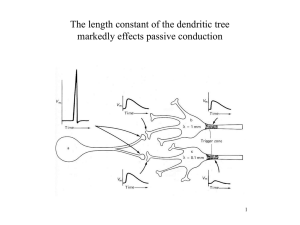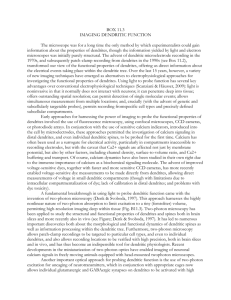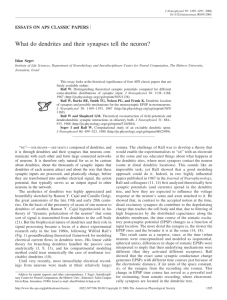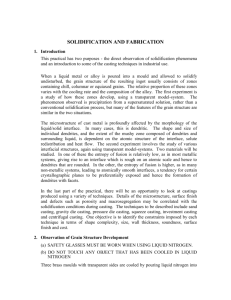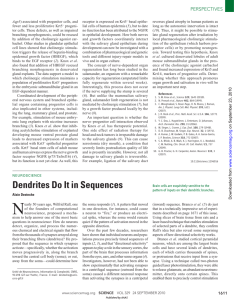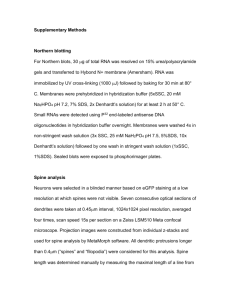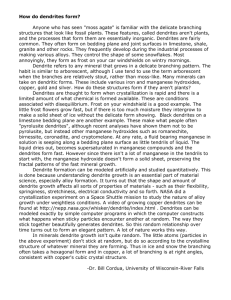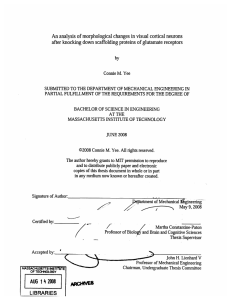Distinctive Roles for Dendrites in Neuronal Computation
advertisement
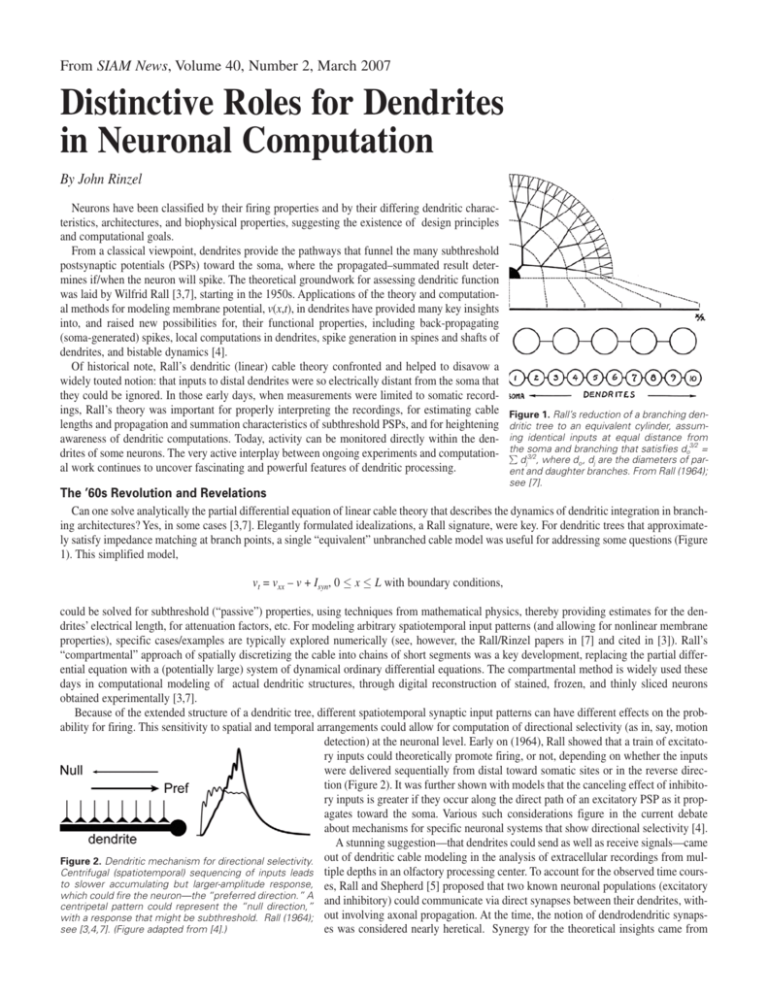
From SIAM News, Volume 40, Number 2, March 2007 Distinctive Roles for Dendrites in Neuronal Computation By John Rinzel Neurons have been classified by their firing properties and by their differing dendritic characteristics, architectures, and biophysical properties, suggesting the existence of design principles and computational goals. From a classical viewpoint, dendrites provide the pathways that funnel the many subthreshold postsynaptic potentials (PSPs) toward the soma, where the propagated–summated result determines if/when the neuron will spike. The theoretical groundwork for assessing dendritic function was laid by Wilfrid Rall [3,7], starting in the 1950s. Applications of the theory and computational methods for modeling membrane potential, v(x,t), in dendrites have provided many key insights into, and raised new possibilities for, their functional properties, including back-propagating (soma-generated) spikes, local computations in dendrites, spike generation in spines and shafts of dendrites, and bistable dynamics [4]. Of historical note, Rall’s dendritic (linear) cable theory confronted and helped to disavow a widely touted notion: that inputs to distal dendrites were so electrically distant from the soma that they could be ignored. In those early days, when measurements were limited to somatic recordings, Rall’s theory was important for properly interpreting the recordings, for estimating cable lengths and propagation and summation characteristics of subthreshold PSPs, and for heightening awareness of dendritic computations. Today, activity can be monitored directly within the dendrites of some neurons. The very active interplay between ongoing experiments and computational work continues to uncover fascinating and powerful features of dendritic processing. Figure 1. Rall’s reduction of a branching dendritic tree to an equivalent cylinder, assuming identical inputs at equal distance from the soma and branching that satisfies do3/2 = ∑ dj3/2, where do , dj are the diameters of parent and daughter branches. From Rall (1964); see [7]. The ’60s Revolution and Revelations Can one solve analytically the partial differential equation of linear cable theory that describes the dynamics of dendritic integration in branching architectures? Yes, in some cases [3,7]. Elegantly formulated idealizations, a Rall signature, were key. For dendritic trees that approximately satisfy impedance matching at branch points, a single “equivalent” unbranched cable model was useful for addressing some questions (Figure 1). This simplified model, vt = vxx – v + Isyn, 0 ≤ x ≤ L with boundary conditions, could be solved for subthreshold (“passive”) properties, using techniques from mathematical physics, thereby providing estimates for the dendrites’ electrical length, for attenuation factors, etc. For modeling arbitrary spatiotemporal input patterns (and allowing for nonlinear membrane properties), specific cases/examples are typically explored numerically (see, however, the Rall/Rinzel papers in [7] and cited in [3]). Rall’s “compartmental” approach of spatially discretizing the cable into chains of short segments was a key development, replacing the partial differential equation with a (potentially large) system of dynamical ordinary differential equations. The compartmental method is widely used these days in computational modeling of actual dendritic structures, through digital reconstruction of stained, frozen, and thinly sliced neurons obtained experimentally [3,7]. Because of the extended structure of a dendritic tree, different spatiotemporal synaptic input patterns can have different effects on the probability for firing. This sensitivity to spatial and temporal arrangements could allow for computation of directional selectivity (as in, say, motion detection) at the neuronal level. Early on (1964), Rall showed that a train of excitatory inputs could theoretically promote firing, or not, depending on whether the inputs were delivered sequentially from distal toward somatic sites or in the reverse direction (Figure 2). It was further shown with models that the canceling effect of inhibitory inputs is greater if they occur along the direct path of an excitatory PSP as it propagates toward the soma. Various such considerations figure in the current debate about mechanisms for specific neuronal systems that show directional selectivity [4]. A stunning suggestion—that dendrites could send as well as receive signals—came out of dendritic cable modeling in the analysis of extracellular recordings from mulFigure 2. Dendritic mechanism for directional selectivity. Centrifugal (spatiotemporal) sequencing of inputs leads tiple depths in an olfactory processing center. To account for the observed time coursto slower accumulating but larger-amplitude response, es, Rall and Shepherd [5] proposed that two known neuronal populations (excitatory which could fire the neuron—the “preferred direction.” A and inhibitory) could communicate via direct synapses between their dendrites, withcentripetal pattern could represent the “null direction,” with a response that might be subthreshold. Rall (1964); out involving axonal propagation. At the time, the notion of dendrodendritic synapssee [3,4,7]. (Figure adapted from [4].) es was considered nearly heretical. Synergy for the theoretical insights came from simultaneously discovered anatomical evidence for these dendrodendritic synapses. The modeling paper sparkled, with several gems of theory: reciprocal excitatory and inhibitory synapses at the same location, a new mechanism for lateral inhibition, the importance (or not) of back-propagating action potentials, among others. Segev [6] and I agree, the paper is inspirational for its depth, idealization, artistry, and originality. Dendrites Can Enhance Coincidence Detection A case study from the auditory brain stem illustrates how a particular dendritic architecture and synaptic input distribution can underlie a specific computational role for dendrites. The first neurons in the auditory pathway that receive bilateral inputs have bipolar dendrites, with each dendritic tree getting input from only one ear. These neurons perform coincidence detection with incredible temporal resolution (in the sub-millisecond range) in their role of computing interaural arrival time difference (ITD), a cue for sound localization. In our modeling study [1] we found enhanced sensitivity to ITD when inputs from the two ears are segregated to different dendrites, rather than, say, being on the soma (or all on just one dendrite). Our explanation harkens back to a general property [3,7]: The summation of sizable synaptic inputs is generally nonlinear—that is, the input currents from nearby synapses add less than Figure 3. Detection of coincident inputs is linearly. Because Isyn = gsyn′(v – vsyn), the current generated by a synaptic input conductance gsyn(t) facilitated when inputs are on separate denis reduced as v gets closer to vsyn; if, for example, gsyn is doubled, v tends toward vsyn but Isyn is drites. If all inputs came to one dendrite, the less than doubled. The neuron might fire if bilateral inputs occur on different dendrites (meaning summation would be sublinear and the neuless nonlinear reduction), whereas putting the inputs on the same dendrite might preclude firing ron might not fire. Agmon-Snir et al. (1998); see [1,3,4]. (Figure adapted from [4].) (Figure 3). Hence, the segregation of inputs to different dendrites and sublinear effects combine to reduce the likelihood of firing to inputs (for, say, a pure tone stimulus) from just one ear, thereby reducing false positives in these coincidence-detecting neurons. We further applied the model to argue that, as in some birds, across this neuronal population dendritic length correlates with the sound frequency band as selected by the cochlear filter and delivered via the auditory nerve (neurons with shorter dendrites receive input from higher-frequency sounds). Recording from these neurons’ dendrites, although difficult, is now under way. The models are being tested and are evolving to accommodate very recent discoveries on sound localization and ITD sensitivity that challenge the classical conceptual model (of Jeffress) for sound localization [2]. References [1] H. Agmon-Snir, C.E. Carr, and J. Rinzel, A case study for dendritic function: Improving the performance of auditory coincidence detectors, Nature, 393 (1998), 268–272. [2] B. Grothe, New roles for synaptic inhibition in sound localization, Nat. Rev. Neurosci., 4 (2003), 540–550. [3] C. Koch, Biophysics of Computation, Oxford University Press, London and New York, 1999. [4] M. London and M. Hausser, Dendritic computation, Annu. Rev. Neurosci., 28 (2005), 503–32. [5] W. Rall and G.M. Shepherd, Theoretical reconstruction of field potentials and dendrodendritic synaptic interactions in olfactory bulb, J. Neurophysiol., 3l (1968), 884–9l5. [6] I. Segev, What do dendrites and their synapses tell the neuron? (An Essay on Classics), J. Neurophysiol., 95 (2006), 1295–1297. [7] I. Segev, J. Rinzel, and G.M. Shepherd, eds., The Theoretical Foundation of Dendritic Function: Selected Papers of Wilfrid Rall with Commentaries, MIT Press, Cambridge, Massachusetts, 1994. John Rinzel is a professor of neural science and biology at the Courant Institute of Mathematical Sciences, New York University.

